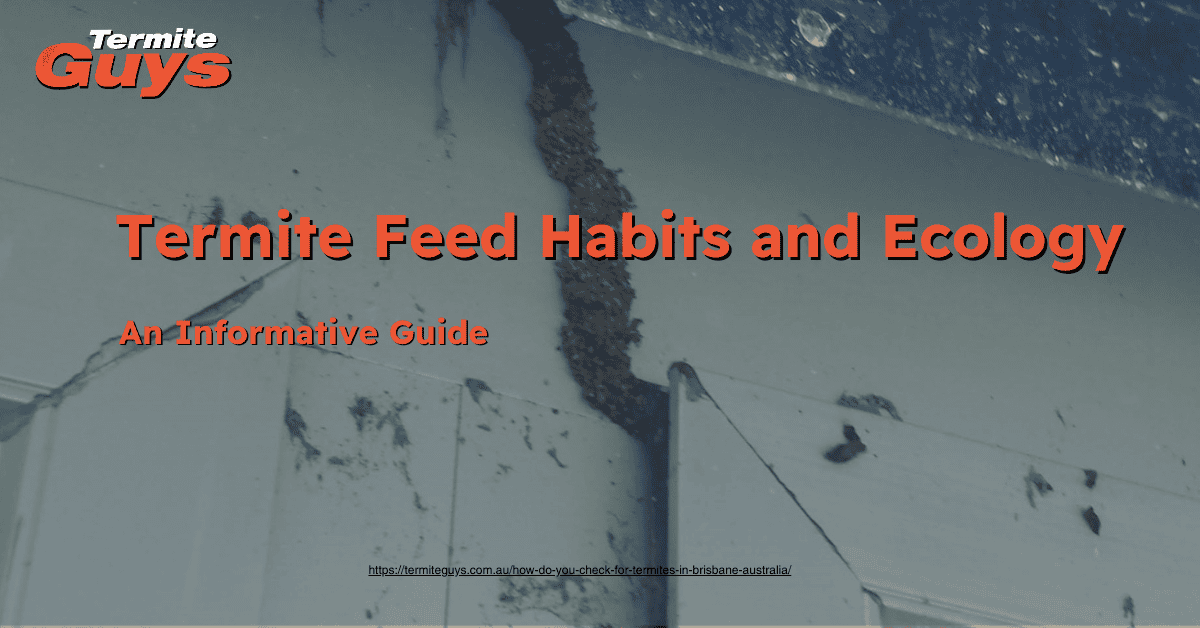Termites are often viewed as destructive pests, but they play a crucial role in the ecosystem. Understanding their feeding habits, diet, and seasonal activity can help homeowners identify potential infestations early and take necessary actions. This guide aims to educate readers on termite ecology, signs of infestations, and when to contact a termite inspection company.
For expert inspection and treatment services in Brisbane, reach out to Termite Guys Brisbane at
(07) 3393 3515. Protect your home from termites today!
Overview of Termite Diet
Termites primarily feed on cellulose, a complex carbohydrate found in wood, plants, and paper. Their diet consists of:
- Wood: The most common food source for termites, especially in homes, includes structural timbers, flooring, and furniture. Subterranean termites consume wood from the inside out, leaving a thin veneer, while drywood termites directly infest wood above ground.
- Plant Materials: Termites also feed on dead trees, decaying plant matter, and leaf litter. Some species target living trees, especially if they are weakened or stressed, making them a threat to gardens and landscapes.
- Other Sources: While wood is their primary food source, termites can consume any material containing cellulose, including books, insulation, and even drywall.
Termite Eating Habits and Ecological Impact
Termites’ ability to break down cellulose makes them crucial decomposers in the ecosystem. They aid in nutrient cycling by decomposing dead trees and plant matter, enriching soil quality. However, their feeding habits can have a destructive impact when they target human structures:
- Subterranean Termites: Known for their extensive underground colonies, they build mud tubes to access above-ground wood sources. They can cause significant structural damage to homes by hollowing out wood from the inside.
- Drywood Termites: They infest dry wood, often entering homes through attics, furniture, or wood siding. They can establish colonies in isolated pieces of wood, making them harder to detect.
Seasonal Activity and Peak Foraging Times
Termites are more active during warmer months, particularly in spring and summer, when they swarm to establish new colonies:
- Spring Swarming: Many termite species swarm in spring, particularly after rain. This is when reproductive termites leave their colonies to mate and start new colonies.
- Summer Foraging: Warm temperatures in summer encourage peak foraging activity. During this time, termites are actively searching for food sources, increasing the risk of infestations.
- Winter Dormancy: In cooler climates, termites become less active but do not die off. They retreat deeper into their colonies to conserve energy.
Signs of Termite Infestations
Early detection of termite activity is key to preventing extensive damage. Here are some common signs of an infestation:
- Mud Tubes: Subterranean termites build mud tubes along walls, foundations, or crawl spaces to protect themselves from dehydration while traveling.
- Hollow-Sounding Wood: Tapping on wood that has been infested often produces a hollow sound, indicating that termites have consumed the interior.
- Discarded Wings: Swarmers shed their wings after mating. Finding piles of wings near windowsills or doorways is a clear sign of a potential infestation.
- Frass: Drywood termites produce frass, or wood-colored droppings, often found in small piles near infested areas.
- Buckling or Sagging Floors: Termite damage can cause structural issues, such as warped wood or sagging floors.
When to Contact a Termite Inspection Company
If you notice any signs of termite activity or suspect an infestation, it is crucial to act quickly. Here’s when to call a professional:
- At the First Sign of Infestation: If you see mud tubes, discarded wings, or any other signs mentioned above, contact a termite inspection company immediately to assess the situation.
- Regular Inspections: Even if you haven’t noticed any signs, scheduling regular termite inspections is a proactive measure. Professional inspections can detect termite activity early and prevent costly damage.
- After Rainy Seasons: Swarmers are more active after rains. Scheduling an inspection post-rainy season can help catch any new infestations early.
- Before Buying or Selling Property: A termite inspection is crucial in real estate transactions to ensure the property is free of infestations and protected from future issues.
Concluding Thoughts!
Termites, while vital to the ecosystem, can pose a severe threat to homes and properties. By understanding their feeding habits and seasonal activity patterns, homeowners can be vigilant in detecting signs of infestations early.
Take Action:
Don’t wait until termites cause significant damage to your property. If you suspect termite activity, contact a professional termite inspection company immediately. For expert inspection and treatment services in Brisbane, reach out to Termite Guys Brisbane at (07) 3393 3515. Protect your home from termites today!


